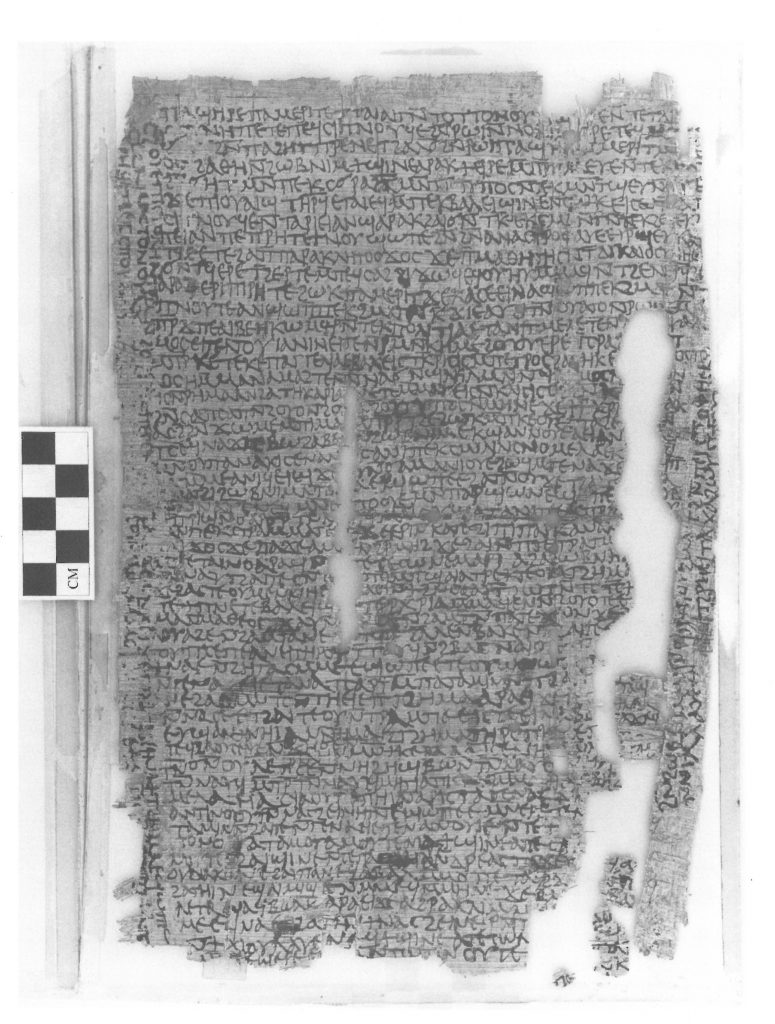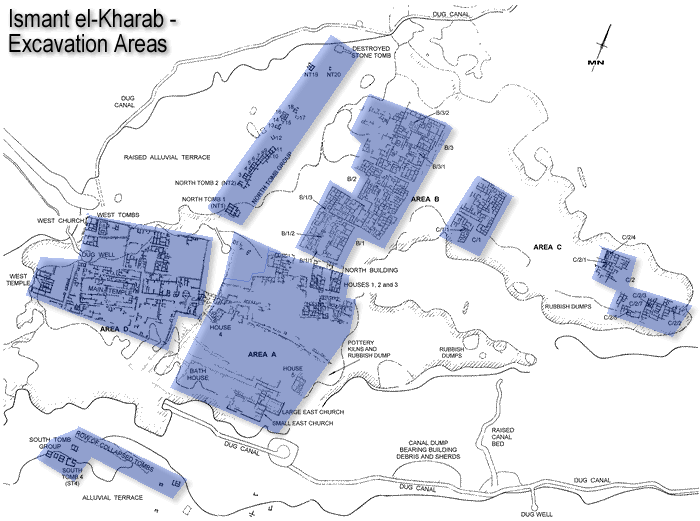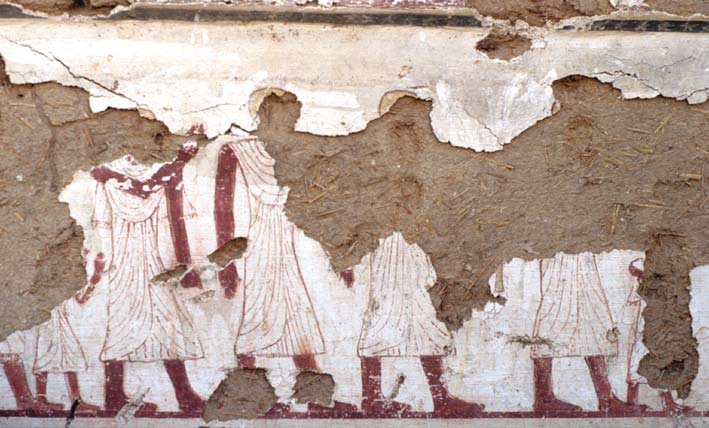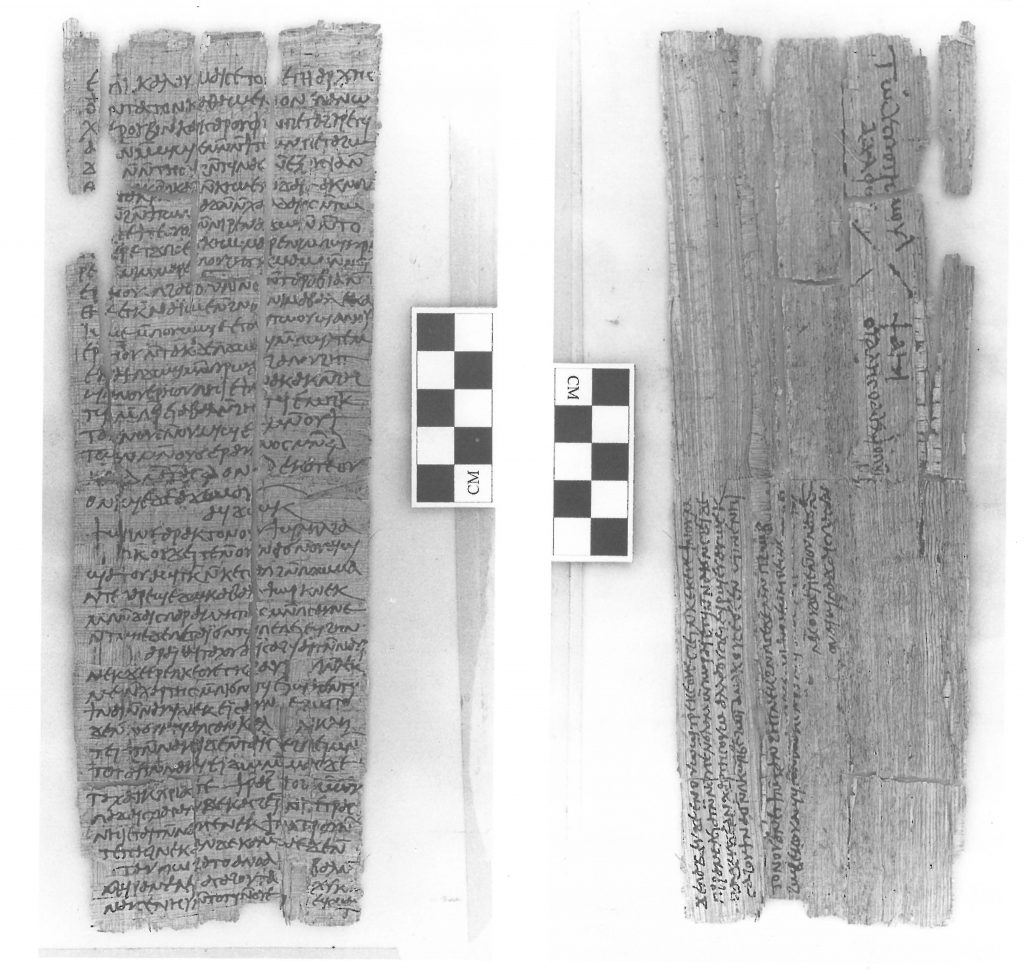
In one of the earliest surviving Coptic letters, a man named Makarios wrote to his son:
My son, my beloved one who is greatly honoured by me: the child of righteousness; the one whose good reputation is in my mouth at every moment, whose testimony remains in my heart; (whose) name is sweet in my mouth, my beloved son Matheos.
P. Kell. Kopt. 19 ro ll.1-4
A good Christian, he continues by imparting some paternal advice:
Do not earn fault or mockery by your… conduct. Study your Psalms, in Greek or Coptic, (every) day.
P. Kell. Kopt. 19 ro ll.12-14
But what might be surprising to us is that although Makarios and Matheos thought of themselves as faithful Christians, they were what modern scholars call Manichaeans, followers of the prophet Mani (216-276 CE), a man from near modern Baghdad who founded a new religious movement building upon the traditions of Zoroastrianism, Buddhism, and Christianity. In the Roman Empire, of which Egypt was part, it presented itself in a particularly Christian form, with Mani described as the Paraclete (“Comforter”) whom Jesus had promised to send after his departure for heaven.
The location of Kellis (modern Ismant el-Kharab)
Matheos lived in Kellis, a small town in the Dakhlah oasis, 350 kilometres from the Nile, while his father Makarios lived in the Nile Valley itself, which the inhabitants of Kellis referred to as “Egypt” (kême). The excavation of Kellis, ongoing since 1986, has provided us with an important glimpse of a settlement from late antique Egypt – rare in a country where continuous occupation means that ancient cities are often directly beneath modern ones. Kellis seems to have been settled in the first or second century CE, and to have been abandoned around the year 400, perhaps because the water supply had been overexploited. This sudden abandonment has allowed archaeologists to reconstruct much of the fourth century town.

What we find is an interesting cross-section of fourth-century religious practice. The primary temple was probably as old as the town itself, and was dedicated to the sphinx god Tutu, his mother Neith, and his wife Tapshai. The temple seems to have been in operation until at least the 330s, the last decade that we have evidence for priests. Christianity probably came to Kellis in the late third century, and three fourth-century churches have been found there, already showing some of the characteristic features of orthodox Egyptian churches which survive to this day; they are among the oldest known churches in the world. One of them, known as the small east church, was converted from an older house church.

SOURCE
The emperor Diocletian (284-305 CE) was a famous persecutor of Christians, but he also targeted Manichaeans, and the community may have come to Kellis from the Nile Valley around the time of these persecutions. The inhabitants of at least 3 houses near the temple seem to have been Manichaeans, members of the lay order known as “hearers”; among their religious responsibilities was supporting the ascetic order known as the “Elect”, who may have had a monastery nearby.
The structure known as House 3 has preserved the largest number of texts, among them the letter cited at the beginning of this post. There are nearly 300 texts written in Greek, Coptic and Syriac, mentioning several individuals whose relationships to one another are not completely clear. It seems there was at least one, and perhaps two, families who lived in the house for five generations in the fourth century. The texts attest to a range of activities – copying books, weaving clothes, borrowing and lending money, sending alms to the elect – by both men and women. As one of the editors of these texts, Iain Gardner, has observed, it is hard to draw a line between home economy and business in this time and place – weaving, for example, was a standard household activity for women in Roman Egypt, and they could produce clothing both for their families, and for sale; several of the letters discuss selling cloth and clothing. Most of the business was carried on in Greek, while Coptic was used for more personal communication. Syriac was the language in which Mani wrote, and the house had a few religious texts in Syriac, as well as a list of Syriac vocabulary with their Coptic translations.

Alongside these more mundane activities, a few magical texts have been found in the house. One of them is a handbook containing a few healing spells written in Greek, still the predominant language of magic in the fourth century. Two others are short amulets for protecting individuals; one of these, on a long thin strip, seems to have been copied from the handbook for the use of a man named Pamour, a name belonging to two inhabitants of the house. Like many of the Greek-language magical papyri of the fourth century, these mention the traditional Egyptian gods, such as Thermouthis (Renenutet), the cobra goddess of the harvest.
Perhaps the most interesting text, though, is written in Coptic, and probably dates to the 360s CE. It is a letter from a man named Vales to another named Pshai. Vales appears in one other letter, and may have been a monastic scribe, while several individuals in House 3 family have the name Pshai; this one seems to also have been a professional or semi-professional scribe. The letter tells us that Pshai had asked Vales to send him a copy of a magical text, but that Vales could not find the right one. Instead, he sent another that he had close at hand, and promised to send the right one if he found it. In return, he asks Pshai to copy a different text and send it back to him. This little exchange is missing much of its context, but it still provides us with the fullest information we have about the transmission of magical texts in Egypt, which consists here of literate individuals sending copies of texts to one another from their collections.

The text that Vales managed to find is a separation spell, intended to break up a romantic couple. It begins with a short Greek passage calling upon the Judaeo-Christian god:
I call upon you, the one who has existed from the beginning, the one who sits over the Cherubim and Seraphim…
P. Kell. Copt. 35 ro ll.1-3
The spell then shifts to Coptic, calling upon God to make the heart of the two victims “black” towards one another, and to put a burning into their hearts towards one another. The ritual described in the text involved burning mustard, so that the hearts of the two victims are to be made “black” and “burned” just as the mustard is – similar separation spells using mustard are attested in the earlier Greek and later Coptic-language traditions. Finally an object – either the mustard or an inscribed papyrus, or perhaps both – is placed in the house in which the victims live, and told:
The house in which I place you: do not leave it until you have caused conflict and strife and thundering between NN and NN.
P. Kell. Copt. 35 ro ll.16-20
The Manichaean community at Kellis is important for our understanding of life in Roman Egypt for many reasons, but for our understanding of magic it is particularly important. The inhabitants of House 3, Manichaeans who thought of themselves as good Christians, do not seem to have been averse to using healing amulets which drew upon the traditional gods, or asking for separation spells from their friends in other towns. We do not know if Pshai wanted to use the separation spell himself – if he was infatuated with someone in another relationship, or wanted to destroy a relationship he disapproved of – or if he was a professional “magician”, who might have wanted to carry out this ritual for someone else. But the text demonstrates the way in which magic could be “Christianised”, with practices which were not inherently Christian – separation spells which worked by burning mustard – being addressed to the Christian god.
The Manichaean community in Kellis seems to have disappeared at the end of the fourth century, and it is unclear if this was simply linked to the general abandonment of the site, or to the persecutions launched by the Christian emperor Theodosius (379-395 CE). In either case, it represents both an interesting footnote in the history of Christian magic, and an illustration of broader trends.
References and Further Reading
Ismant el-Kharab, Ancient Kellis
Official website of the Kellis excavations at Monash University
de Haro Sanchez, Magali. “Les Papyrus Iatromagiques Grecs de Kellis,” Lucida Intervalla 37 (2008), pp.91-93.
Discussion of the magical texts from Kellis in their archaeological context.
Gardner, Iain, Anthony Alcock and Wolf-Peter Funk (eds.), Coptic Documentary Texts from Kellis I, Oxford: Oxbow Books 1999.
Source of the two letters cited here; they are numbers 19 and 35 respectively.
Le Tiec, Agnès. “Le temple de Toutou et l’histoire des manichéens à Kellis”. Journal of Coptic Studies 15 (2013), pp.75-85.
Discussion of the religious history of Kellis.
Mirecki, Paul, Iain Gardner and Anthony Alcock, “Magical Spell, Manichaean Letter,” in Emerging from Darkness: Studies in the Recovery of Manichaean Sources, edited by Paul Mirecki and Jason Beduhn (Leiden: Brill, 1997), pp.1-32.
Fuller discussion of the letter containing a magical spell, P. Kell. Copt. 35
Worp, K. A., J.E.G. Whitehorne, J. E. G. and R.W. Daniel, Greek Papyri from Kellis: I, Oxford, Oxbow Books, 1995.
Greek texts from Kellis; the amulets and handbook mentioned here are numbers 85, 86, 87.

2 Comments
Anthony Alcock
Mirecki, Paul, Iain Gardner and Anthony Alcock, “Magical Spell, Manichaean Letter,” in Emerging from Darkness: Studies in the Recovery of Manichaean Sources, edited by Paul Mirecki and Jason Beduhn (Leiden: Brill, 1997), pp.1-32.
I was the first person to read and identify this text (on site in the oasis). The translation provided in Mirecki’s publication is substantially the one I made.
Anthony Alcock
Korshi
It must have been a very exciting moment! This is certainly one of the most important magical texts ever discovered in Egypt.